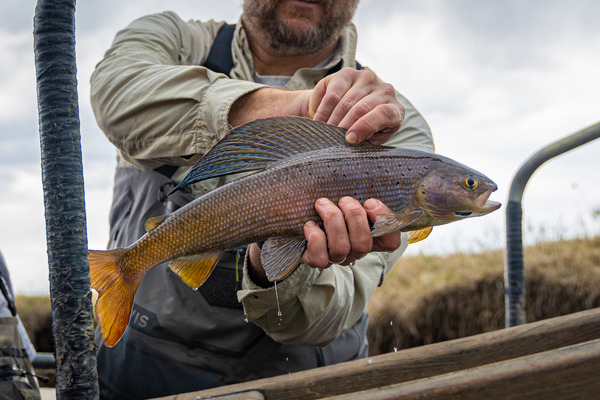
|
How fisheries managers are experimenting with new opportunities for Arctic grayling
Arctic grayling populations in southwestern Montana continue to benefit from a variety of collaborative, longstanding projects involving fisheries biologists and partner organizations.
This year’s efforts for grayling include ongoing partnerships with irrigators to maintain stream flows; notching beaver dams during the spring spawning season to open an additional 36 miles of habitat; introducing more than a million eggs in creeks and thousands of fish in lakes and reservoirs; and conducting habitat and population monitoring surveys, to name a few.
A particularly bright spot in this work comes from French Creek in the Big Hole drainage, where grayling are getting re-established as part of a native fish restoration project. Annual grayling stocking in French Creek began in 2022 with a mix of eggs and live fish. This spring, fisheries biologists found all three year classes of grayling stocked so far to be present in French Creek.
“That’s a really good sign,” said Ryan Kreiner, a native fish biologist for Montana Fish, Wildlife & Parks who focuses on grayling conservation in southwestern Montana. “It doesn’t mean we’re done; it just means, as of now, we’re where we want to be.”
French Creek is an example of a recent approach fish managers are taking to aim for more successful Arctic grayling introductions. This entails stocking grayling in conjunction with large-scale restoration projects for other native fish that involve removing non-native species upstream from a fish barrier.
While these kinds of restoration projects are common for species like westslope cutthroat trout, they also present opportunities for expanding grayling into new areas with quality habitat free of competition with non-native species. It also provides a more selective list of waterbodies that hold greater chances for success.
So instead of stocking 10,000 eggs in many smaller locations with less promising conditions, biologists can stock 100,000 eggs in fewer, larger areas with excellent conditions.
“We’re putting more eggs in fewer places, and we’re looking at introduction sites where grayling are more likely to take hold,” Kreiner said.
Other such drainages include the upper Gibbon River, which includes Grebe Lake in Yellowstone National Park, and the Selway drainage, where the second year of grayling stocking happened in September.
The road to success in these efforts is long but well defined: biologists hope to see stocking-assisted grayling populations reproducing naturally for at least 10 years before calling them a success. That’s one of many metrics that support an overarching mission to protect the abundance and genetic health of indigenous grayling populations in the Big Hole and Centennial Valley drainages.
Putting more eggs in fewer, better baskets is one promising way to get there.
“I’m pretty hopeful that we’re going to start seeing good results, especially in French Creek, Selway and the upper Gibbon,” Kreiner said.
For more information about Arctic grayling conservation in Montana, click here.